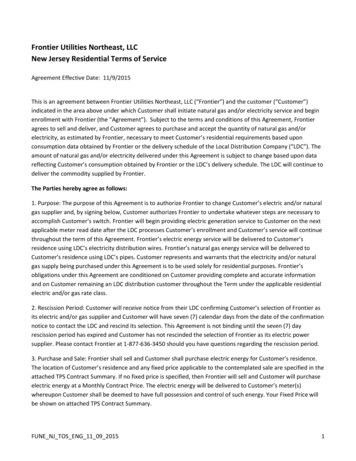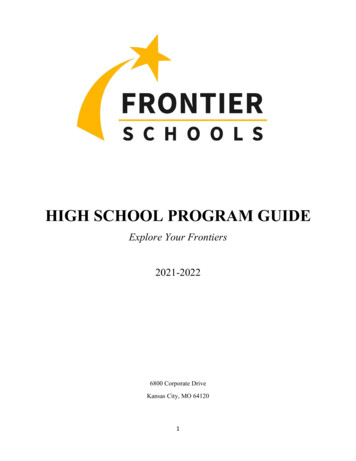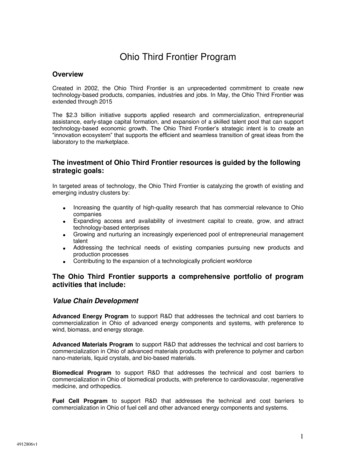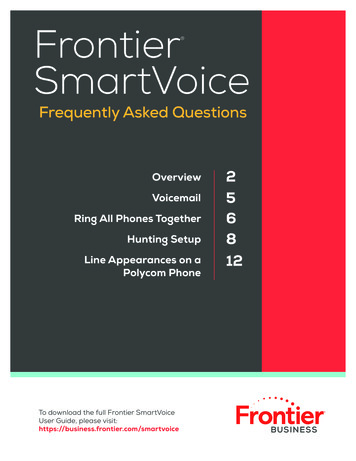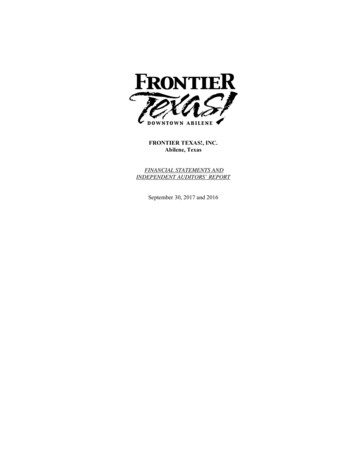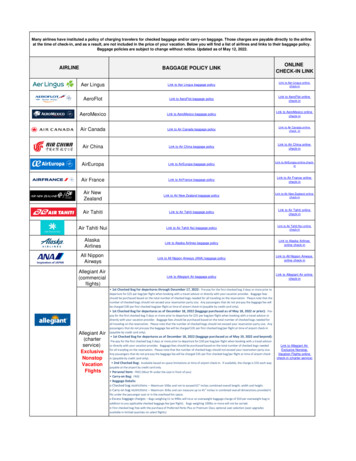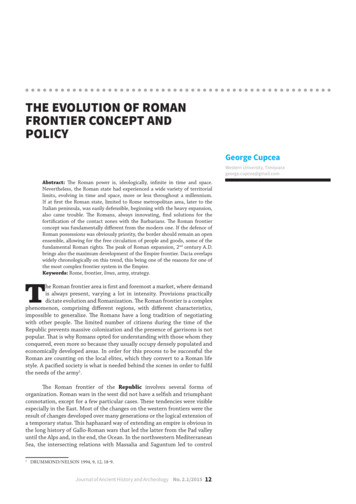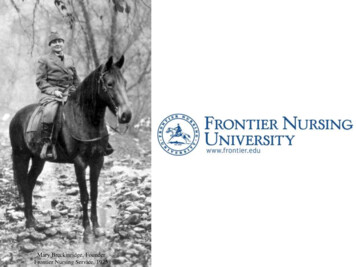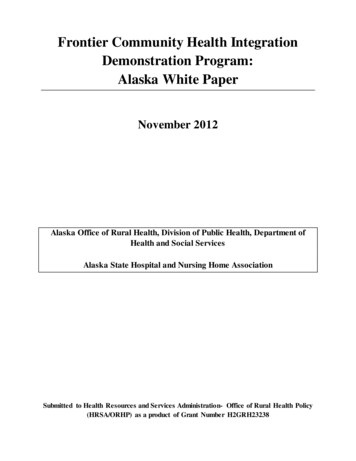
Transcription
Frontier Community Health IntegrationDemonstration Program:Alaska White PaperNovember 2012Alaska Office of Rural Health, Division of Public Health, Department ofHealth and Social ServicesAlaska State Hospital and Nursing Home AssociationSubmitted to Health Resources and Services Administration- Office of Rural Health Policy(HRSA/ORHP) as a product of Grant Number H2GRH23238
Table of ContentsI. EXECUTIVE SUMMARY. 3II. INTRODUCTION AND BACKGROUND. 4III. VISION. 5IV. ALASKA FRONTIER CRITICAL ACCESS HOSPITALS: AN OVERVIEW . 6V. RATIONALE . 9VI. PAYMENT / REIMBURSEMENT CONSIDERATIONS. 13VII. RECOMMENDATIONS AND CONCLUSION . 15APPENDIX A: Description of Alaska F-CHIP Eligible Hospitals. 16APPENDIX B: Services Available in the Alaska F-CHIP Communities . 19APPENDIX C: Medicare Inpatient Stays in F-CHIP Communities. 21This Alaska White Paper represents the input and opinions of chief executive officers and chieffinance officers from Alaska Critical Access Hospitals (CAH) that are eligible to participate inthe CMS Frontier Community Health Integration Demonstration Program (F-CHIP). Throughthis AK White Paper, they have provided feedback on the F-CHIP authorizing language. Theyalso provided comments on Montana’s F-CHIP White Papers which proposed criteria andrecommendations for implementation of the CMS F-CHIP demonstration. Many of the MTrecommendations are acceptable to AK CAHs; however, there are additional recommendationspresented in this White Paper that support AK’s unique needs. The AK F-CHIP eligiblehospitals’ White Paper is provided to assure that the demonstration project will be workable inAlaska as well as Montana, Wyoming and North Dakota.Hospital representatives provided input through conference calls, facilitated discussions, surveysand emails. Also contributing to the process were: Alaska State Hospital and Nursing HomeAssociation, Alaska Department of Health and Social Services, Montana Health Research andEducation Foundation, ACS Xerox, Health Resources and Services Administration- Office ofRural Health Policy, Center for Medicare and Medicaid Services-Center for Medicare andMedicaid Innovation, and Montana Critical Access Hospitals.Frontier Community Health Integration Demonstration Program: Alaska White PaperPage 2
I.Executive SummaryThe Frontier Community Health Integration Demonstration (F-CHIP) is authorized underSection 330A of the Public Health Service Act and guided by Section 123 of the MedicareImprovements to Patients and Providers Act (MIPPA). Its purpose is to develop and test newmodels for the delivery of health care services in frontier areas through improving access to, andbetter integration of, the delivery of health care to Medicare beneficiaries through a three yearCMS demonstration project.The F-CHIP endeavor developed in Montana, guided by the experience of Montana’s smallestCritical Access Hospitals. Montana created a framework document and six White Papers.Alaska, Wyoming and North Dakota are also eligible for participation and each state was invitedto submit responses to these papers or develop their own papers. Alaska’s F-CHIP White Paperfocuses on the seven Alaska Critical Access Hospitals (CAH) that qualify for participation in thedemonstration. This paper describes their current operating environment, makes comparisons tothe Montana F-CHIP model where appropriate, and proposes components of a framework for amore efficient and effective delivery system in Alaska. It represents the input and opinions ofthe Alaska hospitals eligible for participation.The primary audience for this paper includes the US DHHS Health Resources and ServicesAdministration’s Office of Rural Health Policy and the Centers for Medicare and MedicaidService’s Center for Medicare and Medicaid Innovation.Alaska’s complex demographics, geography and history shape its correspondingly complexhealth care system. Tribal beneficiaries comprise 20% of the population and themilitary/Veterans comprise another 14%. Approximately 75% of Alaskan communities areinaccessible by road, as are five of the seven CAHs eligible for this F-CHIP Demonstration.Alaska’s eligible CAHs support Montana’s Conditions of Participation (COP) modifications, andchanges to telehealth regulations. In addition, Alaska’s eligible CAHs have developed specificrecommendations for payment modifications in the proposed F-CHIP demonstration, including:1. Creation of a grant or other mechanism for upfront support of Electronic Health Recordscapital expenditures;2. Creation of a grant or other mechanism for upfront support of Care Coordinators at thenursing or social work level;3. Home health, specialty clinics and physician home visits to be included on the cost reportas allowable expenses:4. Waiver of telehealth restrictions contained in Section 1834(m), including:a. Allow telehealth service delivery and reimbursement in the homeb. Allow Medicare reimbursement of diabetes educationc. Increase the telehealth “originating site” facility feed. Allow more flexibility in frontier telehealth privileging and credentialinge. Alaska specific recommendation: Grant or other mechanism for upfront supportfor a Telehealth Coordinator roleCMS investment in testing this budget neutral model will be modest due to the small number ofparticipants. The returns will be significant, yielding valuable information towards increasingaccess to efficient care in our nation’s most isolated communities.Frontier Community Health Integration Demonstration Program: Alaska White PaperPage 3
II. Introduction and BackgroundThe purpose of this White Paper is toprovide an Alaska perspective on theproposed recommendations for theFrontier Community Health IntegrationDemonstration (F-CHIP).No description of Alaska health care canstart without first describing the size anddemographics of the State. By far thelargest state in the union, Alaska is 2.5times the size of Texas. There are 722,718residents making Alaska the fourth leastpopulated state. Alaska has a populationdensity of 1.08 persons per square mile,by far the lowest in the nation1 .The Frontier Community Health IntegrationDemonstration (F-CHIP) is authorized underSection330A of the Public Health Service Act and isalso guided by authorization of Section 123 of P.L.110-275, the Medicare Improvements to Patientsand Provider’s Act of 2008 (MIPPA). The purpose ofthe F-CHIP Demonstration is to develop and test newmodels for the delivery of health care services infrontier areas through improving access to, andbetter integration of, the delivery of health care toMedicare beneficiaries. The authorizing legislationdefines a frontier Critical Access Hospital (CAH) as aCAH located in a county with a population of 6people or fewer per square mile and a daily acutecare census of 5 patients or less. The legislation alsoidentifies four “frontier-eligible” states: Alaska,Montana, North Dakota and Wyoming.Alaskans receive health care through fourdistinct systems:1. Private sector, providing a broad rangeThis white paper focuses on the seven Alaska Criticalof services.Access Hospitals that qualify for participation in the2. Public system, funding some hospitals,F-CHIP demonstration, describing their currentpublic health nursing and behavioraloperating environment, comparisons to the Montanahealth.F-CHIP model where appropriate, and proposing3. Tribal system, which includes 20% ofcomponents of a framework for a more efficient andthe population, far higher than the U.S.effective delivery system in Alaska.average of 2%.4. Military and Veterans’ Administration;military accounts for 14% of the AK population2 .Having multiple systems increase the challenges to cross-system coordination and economies ofscale at the community level.About 75% of Alaskan communities are inaccessible by road, creating demand for air service,water transport, and the occasional snow machine. Of Alaska’s 27 hospitals, half are not on aroad system and nearly a third of hospitals serve the Anchorage/Mat-Su valley. The AK NativeMedical Center serves as Alaska’s only Level II trauma center; the closest Level 1 traumacenters require a flight to Seattle. Of the seven eligible CAHs, only two are on a road system,four are island-based or obstructed by glaciers, and one is isolated by tundra.Alaska has the second youngest population in the country. The 2010 census counted 7.7% ofAlaskans over 65 years of age, far below the national average of 12.7%. This translates into arelatively low Medicare population, however, the over 65 population is the fastest growingsegment of Alaska’s population3 .1www.census.govAlaska Health Care Commission 2009 Report: Appendix A, Health Care in Alaska.3Alaska Commission on Aging, 2009 2Frontier Community Health Integration Demonstration Program: Alaska White PaperPage 4
III. VisionAlaska’s seven facilities meeting criteriafor inclusion in this demonstration are: Cordova Community Medical Center; Norton Sound Regional Hospital; Petersburg Medical Center; Providence Seward Medical and CareCenter; Providence Valdez Medical Center; Sitka Community Hospital; and Wrangell Medical Center.Alaska’s F-CHIP eligible hospitals seek toparticipate in the CMS Demonstration, increasingaccess to and improving the adequacy of paymentsfor essential health services. The hospitals supportthe Triple Aim4 and seek to provide collaborative,coordinated and increasingly integrated care. Afragmented approach to care delivery cannot bemeaningfully improved without shared incentivesfor access, cost and quality. Residents and providersin rural and frontier Alaska understand access issues- as a matter of life or death when weather prohibits air travel – and also for the practicality ofcost savings from avoided air travel. Medical evacuations from these hospitals to a Level IITrauma Center can cost 70,000, far exceeding the cost of a 96 hour inpatient stay locally.Alaska’s participation in the Frontier Health System model as proposed by Montana iscompromised by the complexity of the local health care systems, reimbursement systemdifferences, and population scarcity compromise. Nevertheless, Alaska’s eligible CAHs supportMontana’s Conditions of Participation (COP) modifications, and changes to telehealthregulations. In addition, Alaska’s eligible CAHs have developed specific recommendations forpayment modifications in the proposed F-CHIP demonstration.Given the dramatic isolation faced in most Alaskan communities, preserving and sustainingaccess to care is paramount. Often lauded for its innovative programs and services, Alaska stillfaces significant issues related to health care access and cost. One of the biggest challengesfacing Alaska’s frontier health care delivery system(s) is integration. Funding silos separate threeof the distinct aforementioned systems; authority sectors create further fissures. To the extent thisCMS Demonstration project can incentivize greater integration; community members willreceive more efficient care.Alaska recommends a CMS demonstration project that increases local capacity and encouragesits integration, further decreasing the volume of patients requiring inpatient stays or costlymedical evacuations to more expensive hospitals. Alaska’s eligible hospitals already retain 49%of their inpatients locally, the same proportion as Wyoming and far more than Montana or NorthDakota. With CMS support in a demonstration, these Alaska facilities believe they can reducethe volume of medical evacuations by a minimum of 5% and reduce total inpatient stays by 2%,resulting in savings of over 1 million annually.The demonstration project’s success would be measured in overall cost savings for Medicarebeneficiaries, including changes to the Medicare Average Daily Census. Upfront support forElectronic Health Records, Telehealth Coordinators and Care Coordinators, and inclusion ofhome health, specialty clinics and physician home visits in the cost report will support theadditional local capacity. In addition, modifications to telehealth payment regulations will furtherreduce costs to CMS.4The Triple Aim: Care, Health, and Cost, by Donald Berwick, Thomas Nolan and John Whittington. Health Affairs,May 2008, Volume 27, number 3. Pages 759-769.Frontier Community Health Integration Demonstration Program: Alaska White PaperPage 5
IV. Alaska Frontier Critical Access Hospitals: An OverviewComplexity of Alaska’s Health Care SystemThe current complexity of Alaska’s health care system can best be described from a historicaland demographic context. The system functions with four distinct sectors. Purchased in 1867,the U.S. Government initiated its public health campaign in the early 1900s under the Bureau ofEducation with nurses on ships traveling to coastal areas and along major rivers. The heartynurses provided care to isolated tribal populations. The Bureau of Education shifted tribal care tothe Bureau of Indian Affairs in 1931, with the development of regional tribal hospitals. FromIndian Affairs to the Indian Health Service to participation in Public Law 93-638, the tribalsystem remains separately funded, serving about 20% of the population.Concurrently, maritime nursing became the foundation of Alaska’s public health system. Today,the 125 public health nurses in 21 public health centers in the Department of Health and SocialServices provide services throughout Alaska. With statehood came public funding to behavioralhealth counseling in communities statewide. Non-tribal hospitals in frontier areas arecommunity-owned, with AK Medicaid and Medicare swing bed funding helping to keep themsolvent.Military involvement commenced with statehood. Alaska’s easy access to Asia ensures a strongmilitary presence, currently representing about 14% of the population. Military personnel andtheir dependents receive health care separately from the civil population. Private sector servicesexist primarily in the larger communities of Anchorage, Juneau and Fairbanks as well as theareas where the F-CHIP eligible CAHs are located. In summary, these funding and authoritybranches result in complex systems of care at the community level.Frontier HospitalsFive of the seven frontier CAHs in Alaska are not connected to a Level II trauma center by road.Air transport, weather permitting, provides the critical linkage to higher level care. Of the CAHswith road access, Seward requires driving 90 miles on a predominantly two lane road and over amajor mountain pass. Valdez requires driving 306 miles on a predominantly two lane road, or aone hour flight, weather permitting. Valdez made national news last winter for 36 feet (437inches) of snowfall. Air and car travel were severely hampered. State acknowledgement of thisgeography will be referenced later in regards to the emergency department standards for CAHsthat exceed the requirements of federal regulation.Table 1: Service Area Population and .10.3RoadCordovaNorton SoundPetersburgProvidence SewardProvidence ValdezService AreaPopulation2,2709,7303,000*4,752*4,000Sitka Comm stance to nearesthospital160 air miles183 air miles31 air miles (CAH)90 miles, 2 lane road306 miles1-7 hrs (air vs auto)3 miles to IHS facility31 air miles (CAH)Distance to Level IITrauma Center160 air miles541 air miles609 air miles125 miles by road306 miles1-7 hrs (air vs auto)600 air miles705 air milesAverage4,7381.3115 miles435 miles* Seward includes Lowell Point, Bear Creek, and Moose Pass. Nome includes surrounding villages.Frontier Community Health Integration Demonstration Program: Alaska White PaperPage 6
It is worth noting that the AK CAHs serve larger populations than the MT CAHs in this project.The AK CAHs serve 2,200 – 9,730 residents, with an average of 4,738 people. In contrast, theMT hospitals serve populations of 644 – 3,790 5 with an average of 1,765 people. Partiallybecause of their geographic isolation, and partially due to the size of the populations they serve,Alaska frontier CAHs provide a relatively broad range of services - especially diagnostic – thatexceed the services reported by the Montana F-CHIP participants. As shown in Appendix B:Services Available in the Community, Alaska’s eligible hospitals provide emergency departmentservices, CT and radiology; several provide mammography and all have telehealth capacity.Ambulance services are all owned by the municipalities, and staffed primarily by volunteers.Alaska CAHs face special staffing challenges because residents seek full-time employment,while hospitals often have a need or funding only for a part-time person. It is difficult to fill parttime positions and the distance between facilities and travel challenges make shared positions anunrealistic option.Unlike their Montana counterparts, Alaska’s frontier CAHs developed a mechanism to retaintheir nursing home beds. The community based care keeps residents and employment in thecommunity. The fiscal underpinning underscores state support for this capacity; CAHs spreadthe recurring costs of LTC beds across several, legitimate hospital services. The daily rate fornursing home beds keep the CAHs from operating at an even greater financial loss.Table 2: Overview of CAH’s Licensed BedsHospital#LicensedBeds23# AcuteBeds/ AvgDaily Census13/0.23# LTC Beds/Avg DailyCensus LTC10/8.91# Acute *ProvidenceValdez**Sitka 3.24NA137/ acute48 / swingCordovaAvg DailyCensusSwingMedicare DailyCensus 2011.071/ acute.36/swingNA/ acute0/ swing0.51/acute2.72/ swing0.42/ acute1.09/ swing.29/ acute.54/swing1.2/acute1.8/ swing0.68/ acute1.58/ swing*Includes labor & delivery and post-partum care.** FY2012Emergency Department Standards for Alaska CAHsAlaska employs stricter provider standards for the Medicare Rural Hospital Flexibility Programthan required under federal statute. Specifically, federal law allows CAHs located in frontierareas and having no greater than ten beds to be staffed with a registered nurse. Further, theemergency response time can be up to 60 minutes.5Framework for a New Frontier Health System Model, MHREF. October 2011, Appendix B.Frontier Community Health Integration Demonstration Program: Alaska White PaperPage 7
In recognition of Alaska’s unusual geography and the need to assure 24 hour availability ofemergency services at the local level, the State created its own emergency department standardsfor CAHs. As stated in the 1998 Alaska Rural Health Plan for participation in the MedicareRural Hospital Flexibility Program:“A CAH must provide Level III emergency medical services, as defined in thefourth edition of Alaska EMS Goals: A Guide for Developing Alaska’s EmergencyMedical Services System, February 1996. Level III services require that theemergency department be staffed on a 24-hour basis by a physician, mid-levelpractitioner, or Registered Nurse with appropriate medical training, equipment, andsupplies and that physicians with specialized emergency care training are availableon-call.”In response, each of Alaska’s CAHs attempts to maintain at least three physicians on staff orcontract at all times to meet this standard. If a hospital elects to close their emergencydepartment at certain times, they must develop and submit a plan documenting that a registerednurse would be on duty at all times. 6Behavioral HealthAccess to behavioral health services plays a significant role in Alaska’s health delivery system.As referenced in Appendix B, behavioral health services exist in all of the CAH communities,whether within a Community Health Center (CHC), tribal organization, or stand-alonecounseling centers. According to a recently released report in the AK Dept of Health and SocialServices, alcohol and substance abuse cost Alaska 1.2B in 2010, with 250M of those fundsgoing to health care and social services. 7 In the report, alcohol/substance abuse and relatedinjuries/illnesses caused 45,500 days of hospital care and 2,239 days of long term care. Alaska’smental health challenges loom every bit as large. The Alaska suicide rate for youth aged 15-24was 46/100,000 in 2010, compared to national rates of 7.8/100,000. 8Alaskans understand that early diagnosis and prevention needs to occur at the community level;hence, the local investment into counseling services. Psychiatric services remain elusive;according to the most recent statewide health workforce assessment (2009), the vacancy rate forpsychiatric nurse practitioners was 20.5% and for psychiatrists was 12.7% 9 . None of the CAHcommunities have these positions. Critical access hospitals do not have the staffing or facilitiesto adequately provide inpatient psychiatric services. An expansion of tele-behavioral healthwould help bring psychiatric care to these isolated communities, providing the broader range ofservices needed to reduce hospital stays and residential services.6Alaska Administrative Code, 7AAC 12.612. Licensure of critical access hospitals.The Economic Costs of Alcohol and Other Drug Abuse in Alaska, 2012 icCostofAlcoholandDrugAbuse2012.pdf8AK Dept of Health and Social Services website, Press Release 9/17/12, accessed cide %20prevention %20grant.pdf92009 Alaska Health Workforce Vacancy Study, published by the UAA AK Center for Rural Health – Alaska’s 2009workforce09.pdf7Frontier Community Health Integration Demonstration Program: Alaska White PaperPage 8
V. RationaleChallengesAlaska and Montana share many similarities. Geographic isolation and low population densityare the most obvious. These characteristics result in challenging secondary factors, such as:a. Low patient volume, resulting in a weak reimbursement base for supporting necessaryinfrastructure;b. Barriers to the recruitment and retention of health professionals;c. Limited home health, hospice, and rehabilitation services, resulting from (a) and (b),essentially these services are reimbursed on a PPS system that is not congruent with lowvolume CAH facilities; andd. Challenges in providing telehealth services, resulting from (a) above and due toregulations providing inadequate support to the originating site.Looking forward, new models for value-based reimbursement currently being developed such asaccountable care organizations, bundled payments, and value-based purchasing may not translatewell in rural markets, given rural providers’ unique regulatory confines and low populationdensity. Also, low patient volumes make it difficult, if not impossible, for rural providers toassume the risk as these models demand. 10, 11Five critical distinguishing factors may compromise Alaska’s participation in the F-CHIPDemonstration as proposed by Montana in their Framework document. Those factors include:1. Increasing the bed limit from 25-35, adding 10 swing beds: The proposed additional swingbeds are designed to provide access to nursing home services and increase volume to supportbudget neutrality necessary for the demonstration’s feasibility. In Alaska, all of the frontierCAHs have separately licensed nursing homes; reasonable Medicaid reimbursement for thesebeds play a crucial role to the hospitals’ financial stability. Alaska CAHs do not oppose thebed expansion, but it is highly improbable they will engage it within the current environment.Thus, expansion of swing beds will not support Alaska CAHs to achieve budget neutrality ina CMS F-CHIP demonstration.2. Exclusion of Selected Psychiatric Inpatients from Length of Stay (LOS) Limits: NorthDakota’s F-CHIP sites often retain their psychiatric inpatients longer than the 96 hour limit.Waiving the 96 hour LOS requirement is beneficial for keeping patients close to family, andin facilities with a lower daily rate. Alaska’s F-CHIP eligible communities all have socialworkers and other behavioral health professionals. Unfortunately, their psychiatric rooms donot include a camera, thus requiring a dedicated clinician with the patient at all times.Further, only three hospitals in Alaska are certified for Evaluation & Treatment, none ofthem CAHs. An expansion of tele-behavioral health would strengthen the provision of localservices, but none of them consider it prudent to retain psychiatric patients over 96 hours.3. Complex Community System of Care: In Montana, the frontier CAHs often serve as theprimary, and often only, source of community-based care. Public health and other services10Anticipating the Rural Impact of Medicare Value-Based Purchasing, RUPRI Rural Health Panel, April 2012Comment Letter from The Rural Wisconsin Health Cooperative to Dr. Donald Berwick, CMS administratorregarding CMS-1345- Accountable Care Organizations & Medicare Shared Savings Program, June 6, 201111Frontier Community Health Integration Demonstration Program: Alaska White PaperPage 9
are often contractually managed through their organization. In Alaska F-CHIP communities,diverse and separate organizations comprise the health care system. All have stand-alonebehavioral health services and public health offices. Two communities have stand-alone 330CHCs or tribal clinics. Some have private pharmacies and physicians in private practice. TheCAHs provide inpatient care, coordinate specialty care services, and offer outpatient services.They collaborate with other community service providers rather than manage them. Alaskaneeds help with incentivizing collaboration, coordination and finally integration. AnAccountable Care Organization (ACO)-like structure would be prohibitively difficult for theCAH to enact in this environment.4. Rural Health Clinics and expanded Visiting Nurse Services: Alaska’s eligible frontier CAHsface barriers to securing rural health clinic status. In order to ensure access to quality care 24hours per day, seven days a week, they attempt to maintain at least three mid-level orphysician providers on staff. Most AK communities with CAHs have low populations andtoo many primary care physicians to qualify as a Health Professional Service Area (HPSA).Some communities use community health centers or tribal health clinics to serve theHPSA/MUA outpatient needs of the population, and they are separately owned and operated.The sole exception is Nome’s Norton Sound Health Corporation, the singular tribal hospitalof the 71 F-CHIP eligible CAHs nationwide. Most Alaska CAHs are not eligible for RuralHealth Clinic status.Figure 1. Alaska's Unique Payer Mix5. Payer Mix: Alaska’s health careSta tepayer mix varies from that of otherRegulatedstates, primarily due to thePl a n Medi caidCommerci aldemographics of a younger34%15%population and large AlaskaNative/American Indian population.Uni nsuredAs evidenced in the payer mix6%graphic, Medicare covers 8% ofSel f-InsuredAlaskans. The Indian Health Service10%covers 16%, and Medicaid covers34%. Private insurance coversMedi careIndianapproximately 15%. From a8%Hea lthstatewide perspective, MedicaidMi l i taryServi ce11%plays the single largest role in16%paying for Alaskans’ health care.Source: Percent of Insurance Coverage by type, Al l Payer ClaimsHowever, in rural areas, Medicare isDa ta bases, Presentation to the Alaska Health Ca re Commission,Freedman Healthcare, LLC, 10/11/12.a much more significant payer ofhospital care. For the separately licensed nursing homes that are part of Alaska CAHs,Medicaid is the largest payer.The table on the next page outlines the role of Medicare in funding inpatient and outpatientcare to the F-CHIP eligible CAHs. All eligible CAHs, other than Nome with a large tribalpopulation, depend on Medicare as an important payer. Clearly, Medicare’s financialrelevance speaks to the importance of testing new delivery models in frontier areas.Frontier Community Health Integration Demonstration Program: Alaska White PaperPage 10
Table 3: Payer Mix: Inpatient and Outpatient CombinedCordovaNome/NortonSoundPetersburgProv SewardProv ValdezSitka ial5.0%3.5%Private .2%/IP22.8%/ OP13.7%/OP38.9%/OP14.7/OP13.4%36.8%4 38.3%9.5%43.9%4.4%4 4.1%/OP39.3%/OP5.3%/OPSource: Reported from hospitals for all patientsApproximately 90% of nursing home care is funded by Medicaid. The tremendous state supportfor community-based nursing home services improves the likelihood of the elderly staying closeto family, friends and familiar surroundings. The Medicaid payment is such that nursing homeservices must be excluded from discrete costing.Table 4: Montana-Proposed Waivers to CAH Conditions of ParticipationMT Proposed ChangeIncreasing the existing CAH 25-bed lim
Frontier Community Health Integration Demonstration Program: Alaska White Paper Page 3 . I. Executive Summary . The Frontier Community Health Integration Demonstration (F-CHIP) is authorized under Section 330A of the Public Health Service Act and guided by Section 123 of the Medicare Improvements to Patients and Providers Act (MIPPA).
